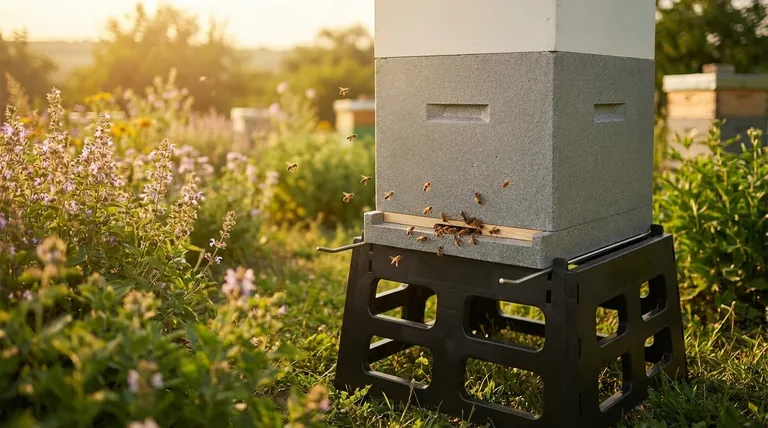The primary advantages of polystyrene hives are superior thermal insulation, lighter weight for easier handling, and significantly lower maintenance compared to traditional wooden hives. These benefits work together to reduce stress on the bee colony and the beekeeper, often leading to improved winter survival rates and higher honey yields.
The decision between polystyrene and wood is a choice between modern efficiency and traditional practice. Polystyrene hives are engineered to conserve the bees' energy, directly impacting their health and productivity by creating a more stable internal environment.

The Core Advantage: Superior Thermal Insulation
A hive's ability to regulate temperature is the single most important factor for a colony's success. Polystyrene's structure gives it a significant performance edge over wood.
How Insulation Impacts Winter Survival
Bees must burn through their honey stores to generate heat and maintain a cluster temperature of around 95°F (35°C) during winter.
Polystyrene provides up to eight times the insulation value of wood. This drastically reduces heat loss, meaning the colony consumes far less honey to survive the cold, emerging stronger in the spring.
Boosting Summer Productivity
Just as it keeps heat in during winter, insulation keeps heat out during summer. In a wooden hive, bees expend significant energy fanning their wings to cool the brood nest on hot days.
In a well-insulated polystyrene hive, bees dedicate less energy to climate control and more energy to foraging for nectar and pollen. This directly translates to increased honey production.
Practical Benefits for the Beekeeper
Beyond colony health, polystyrene hives offer tangible advantages that simplify the physical work of beekeeping.
Significantly Lighter Weight
A full-depth wooden hive box (a "deep") filled with honey can weigh over 80 pounds (36 kg). A comparable polystyrene box is a fraction of that weight, making lifting, inspections, and hive transportation far less strenuous.
This ergonomic benefit is especially valuable for beekeepers with physical limitations or those managing many colonies.
Minimal Maintenance Required
Wooden hives require regular painting or sealing to protect them from rot, mold, and weather. This is an ongoing cost in both time and materials.
Polystyrene is an inert material that does not rot and is impervious to moisture. It never needs painting and can be cleaned easily, saving considerable time and effort over the life of the hive.
Understanding the Trade-offs
While the benefits are substantial, polystyrene hives are not without their downsides. Objectivity requires acknowledging these limitations.
Vulnerability to Physical Damage
High-density polystyrene is durable, but it is softer than wood. It can be gouged by a sharp hive tool or damaged by pests like wax moths or rodents if the colony is not strong enough to defend its entrance.
Beekeepers learn to handle their tools more gently and may need to use entrance reducers or take other pest-prevention measures.
Environmental and Aesthetic Concerns
While polystyrene is technically 100% recyclable, the availability of facilities that process it can be limited. Many beekeepers also simply prefer the traditional, natural aesthetic of wooden hives in their apiary.
Cost and Availability
The initial purchase price of a polystyrene hive is often higher than a basic wooden hive. However, this is frequently offset by a lower total cost of ownership over time due to the lack of maintenance and replacement costs. They may also be less readily available from local suppliers compared to standard wooden equipment.
Making the Right Choice for Your Goals
Your ideal hive material depends entirely on your climate, physical ability, and beekeeping philosophy.
- If your primary focus is maximizing bee health and honey production, especially in harsh climates: Polystyrene's superior thermal performance gives it a clear advantage.
- If your primary focus is reducing the physical strain of beekeeping: The lightweight nature of polystyrene hives will make a significant difference in your workflow.
- If your primary focus is a traditional aesthetic and the ability for easy customization: Wooden hives remain the classic and most adaptable choice, provided you are prepared for the maintenance.
Ultimately, choosing the right hive is about selecting the best tool to help your bees thrive.
Summary Table:
| Advantage | Key Benefit | Impact on Beekeeping |
|---|---|---|
| Superior Insulation | Up to 8x better than wood | Improves winter survival, boosts summer honey production |
| Lighter Weight | Fraction of the weight of wood | Easier handling, reduces physical strain |
| Lower Maintenance | Does not rot; no painting needed | Saves time and long-term costs |
Ready to upgrade your apiary with the efficiency of polystyrene hives? HONESTBEE supplies high-quality, durable beekeeping equipment to commercial apiaries and distributors. Our wholesale-focused operations ensure you get the reliable gear your bees need to thrive. Contact HONESTBEE today to discuss your hive requirements and boost your operation's productivity!
Visual Guide

Related Products
- Plastic Bee Hive Stand for Beekeeping
- Langstroth Bee Hives Bee Keeping Box for Beginners Beekeeping
- Professional Insulated Plastic Bee Hives
- Professional Insulated Winter Hive Wrap for Beekeeping
- Long Langstroth Style Horizontal Top Bar Hive for Wholesale
People Also Ask
- What is the purpose of a hive stand in a Langstroth hive? Protect Your Hive and Boost Colony Health
- What are the advantages of a second hive if the queen is killed? The Ultimate Insurance Policy for Your Apiary
- What are the main differences between Langstroth and Top Bar Hive designs? Choose the Right Hive for Your Beekeeping Goals
- Why is elevating the hive important? A Simple Step for a Healthier, More Productive Colony
- How do bees regulate ventilation and temperature in the hive? Master Hive Climate Control



















